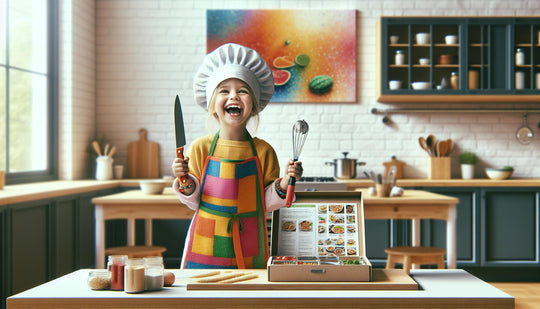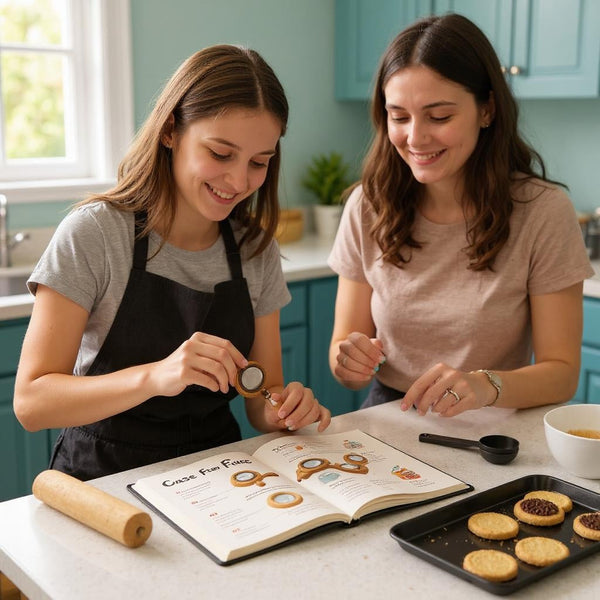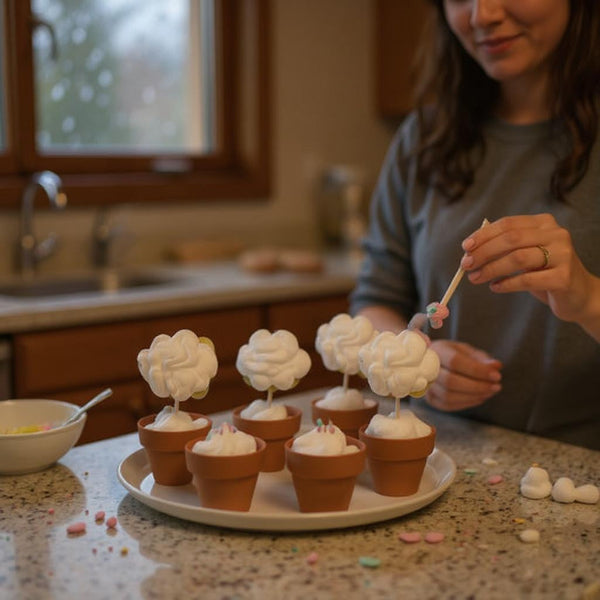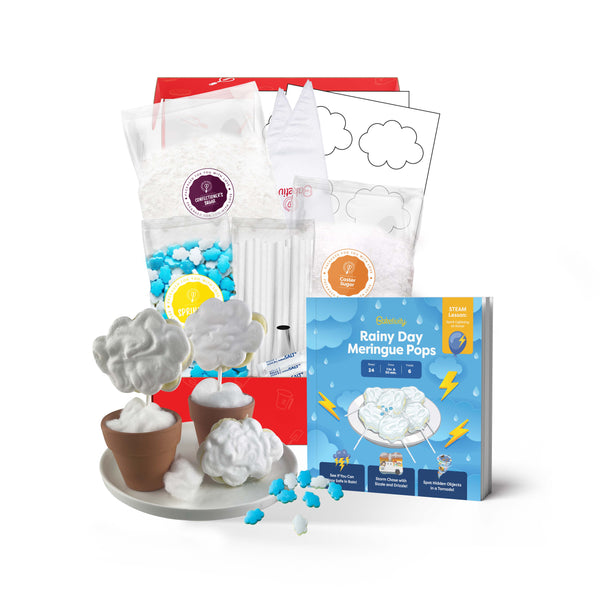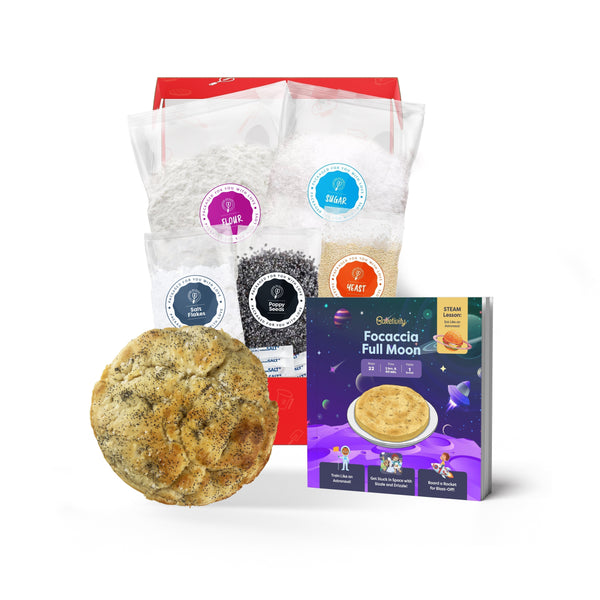Ever tried to cook a gluten-free meal with your kids? It's like trying to herd cats while juggling eggs! But fear not, fellow parents - we've got a solution that'll make your kitchen adventures a piece of (gluten-free) cake.
Enter the gluten-free kids cooking box: a treasure trove of fun, safe ingredients and easy-to-follow recipes. It's not just about avoiding gluten; it's about empowering our little chefs to create delicious meals without worry. How can we make cooking both educational and enjoyable for kids with dietary restrictions? This box might just be the answer we've been looking for.Key Takeaways
- Gluten-free kids cooking boxes offer safe ingredients and easy recipes for children with dietary restrictions
- These boxes teach valuable cooking skills, boost confidence, and encourage healthy eating habits
- Look for age-appropriate recipes, detailed allergen information, and child-friendly kitchen safety tools
- Top boxes on the market offer a variety of recipes, educational content, and eco-friendly packaging options
- Create a kid-friendly kitchen setup and involve children in meal planning to maximize the cooking experience
- Ensure balanced nutrition by focusing on fiber, B vitamins, iron, and calcium in gluten-free meals
What Is a Gluten-Free Kids Cooking Box?
A gluten-free kids cooking box is a curated package of ingredients and recipes designed for children with gluten sensitivities or celiac disease. It's a fun and educational tool that helps kids learn to cook while adhering to their dietary needs.Benefits of Cooking with Kids
Cooking with kids offers numerous advantages. It teaches valuable life skills, boosts confidence, and encourages healthy eating habits. When children participate in meal preparation, they're more likely to try new foods and appreciate the effort that goes into cooking. It's also a great way to spend quality time together and create lasting memories. Remember the first time you tried to crack an egg? Watching a child's face light up when they master this skill is priceless!Top Features to Look for in a Gluten-Free Kids Cooking Box
When selecting a gluten-free kids cooking box, it's crucial to choose one that meets your child's needs and interests. Here are the key features we recommend considering:Age-Appropriate Recipes
A good gluten-free kids cooking box offers recipes tailored to different age groups. For younger chefs, simple no-bake treats might be perfect, while older kids can tackle more complex dishes. Look for boxes that:- Include step-by-step instructions with clear visuals
- Offer a mix of difficulty levels to grow with your child
- Feature fun, kid-friendly recipes like gluten-free pizza or cookies
- Provide options for various meal types (breakfast, lunch, dinner, snacks)
Allergen Information
Detailed allergen information is non-negotiable for gluten-free cooking boxes. The best options will:- Clearly label all ingredients and potential allergens
- Provide substitution suggestions for common allergens
- Include a helpline or chat support for allergen-related questions
- Offer customization options to avoid specific ingredients
Kitchen Safety Tools
Safety first, fun second! A top-notch gluten-free kids cooking box should include age-appropriate kitchen tools designed with little hands in mind. Look for:- Child-sized oven mitts or heat-resistant gloves
- Plastic knives for younger children
- Non-slip cutting boards
- Measuring cups and spoons with easy-to-read markings
Best Gluten-Free Kids Cooking Boxes on the Market
We've scoured the market to find the top gluten-free kids cooking boxes available. These kits offer a blend of fun, education, and safety for young chefs with dietary restrictions. Let's explore the pros and cons of three popular options.Kit A: Pros and Cons
Kit A stands out with its colorful packaging and easy-to-follow recipe cards. The box includes pre-measured ingredients, eliminating guesswork for kids. On the plus side, it offers a wide variety of recipes, from savory main dishes to sweet treats. The kit also provides allergen-free substitutions for common ingredients. However, some parents note that the portion sizes are small, and the kit lacks reusable cooking tools. The recipes might be too simple for older children or those with more cooking experience.Kit B: Pros and Cons
Kit B shines with its focus on international cuisines, introducing kids to gluten-free versions of global dishes. The box includes high-quality, organic ingredients and eco-friendly packaging. A major advantage is the inclusion of child-sized cooking utensils, promoting safety in the kitchen. On the downside, Kit B is pricier than some alternatives. Some users report that the recipes can be time-consuming, which might not suit busy families. Additionally, the exotic flavors might not appeal to picky eaters.Kit C: Pros and Cons
Kit C takes the cake for its educational approach, incorporating science experiments into cooking activities. The box comes with a detailed nutrition guide, helping kids understand the importance of a balanced gluten-free diet. It also offers a points system, encouraging children to try new foods and techniques. However, Kit C's recipes often require additional ingredients not included in the box, which can be inconvenient. Some parents mention that the instructions can be overly complex for younger children. The kit also lacks variety in its dessert options, which might disappoint kids with a sweet tooth.How to Make the Most of Your Gluten-Free Kids Cooking Box
Maximizing your gluten-free kids cooking box creates a fun and educational experience for young chefs. Let's explore how to set up a kid-friendly kitchen and involve children in meal planning to make the most of your cooking adventures.Setting Up a Kid-Friendly Kitchen
A kid-friendly kitchen starts with accessibility. Place child-safe utensils and ingredients at lower heights for easy reach. Use colorful labels on storage containers to help kids identify ingredients quickly. Designate a specific area for mixing and prep work, like a low table or counter space with a non-slip mat. Got a budding chef who can't reach the sink? Try a step stool with handrails for added safety. Remember, a clean kitchen is a happy kitchen. Create a fun cleanup routine by turning it into a game – who can put away the most items in 60 seconds?Involving Kids in Meal Planning
Getting kids involved in meal planning builds excitement for cooking day. Start by flipping through the recipe cards together and asking, "Which dish looks yummy to you?" This simple question can spark their interest and make them feel valued. Create a weekly menu board where kids can draw or write their chosen meals. It's like planning a tasty adventure! For younger children, use a picture-based system with images of ingredients or finished dishes. Don't forget to add a dash of silliness to the process. How about "Wacky Wednesday" where you combine unexpected flavors? Imagine the giggles when you suggest a "broccoli sundae" (spoiler: it's just steamed broccoli with cheese sauce).Nutritional Considerations for Gluten-Free Cooking
Cooking gluten-free meals for kids requires careful attention to nutritional balance and safety. We'll explore key considerations to keep your little chefs healthy and happy in the kitchen.Balancing Nutrients
Gluten-free diets can sometimes lack essential nutrients. How do we make sure our kids get everything they need? Let's break it down:- Fiber: Replace wheat with high-fiber alternatives like quinoa, brown rice, and legumes.
- B vitamins: Include fortified gluten-free cereals and plenty of leafy greens.
- Iron: Cook with cast iron pans and add iron-rich foods like spinach and lean meats.
- Calcium: Don't forget dairy or fortified non-dairy milk alternatives.
Avoiding Cross-Contamination
Cross-contamination is the sneaky villain in our gluten-free kitchen adventure. Here's how we can outsmart it:- Separate utensils: Use different cutting boards, toasters, and colanders for gluten-free foods.
- Clean thoroughly: Wash surfaces and hands frequently to avoid gluten transfer.
- Label everything: Create a color-coding system for gluten-free items. It's like a secret spy code!
- Read labels carefully: Become ingredient detectives and spot hidden gluten.
